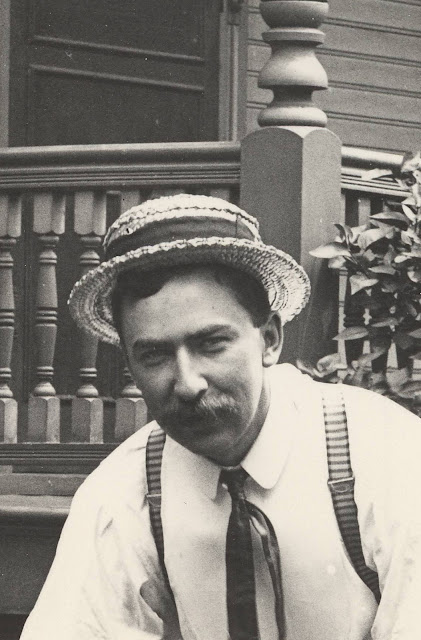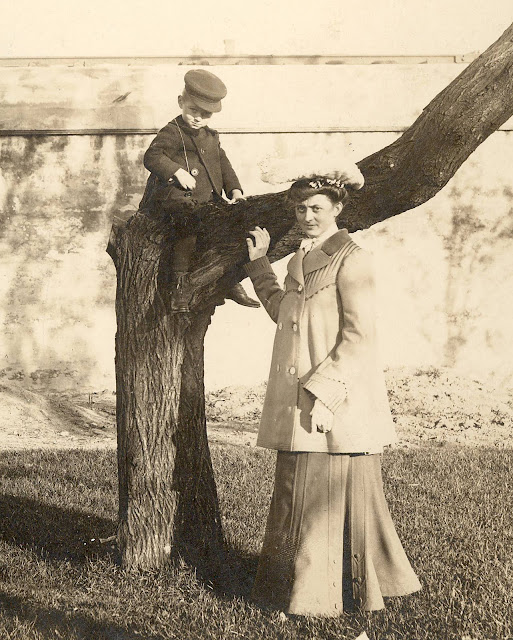Comments by Mary Lee Call, unless otherwise noted:
We are greatly blessed to belong to a family that for generations has loved getting together to laugh, sing, and tell stories. Elzumer Scott, Kenneth’s father, seems to have had an especially keen interest in organizing and documenting family gatherings. In notes he kept for the reunion in 1939, he indicates that his old camera was used to take photos at “our first reunion in 1907.” Elzumer was the oldest child of Aaron Graham Scott, and perhaps that is one reason he felt responsible to promote family unity.
 |
| Children and grandchildren of Aaron Graham Scott (seated on porch), 1909. Kenneth, age 10, is 2nd from left |
 |
| Aaron Graham Scott and family, circa 1917 |
From Aug. 6th to Aug. 11th, 1939, many of the descendants of Aaron Graham Scott gathered at
Big Springs, Idaho.
 |
| Family member examining "Scott Reunion" notice on Big Springs Inn sign |
There was a printed program booklet, including blank pages for notes on each day’s events. Elzumer, who organized the reunion, took careful notes of those in attendance, as well as the activities every day. Notice how the women are always wearing dresses and the men are in suits!
 |
| 1939 Scott Reunion program booklet. The photo of Big Springs is very similar to the ones at the web site linked above. |
The “Reunion Song,” printed in the inside cover of the reunion booklet, really captures the spirit of the Scott family and some of their favorite past times.. It was written by Carrie Mae’s sister-in-law, Evelyn Sallee, “for the Sake of Old Lang Syne,” or in other words, “for old time’s sake,” and sung to the tune of “Oh, Susanna!”
1939 SCOTT REUNION SONG
We’ve gathered from California, we have come from Buffalo,
From Chicago and from Washington, and Indianapolis too;
From Utah, Colorado, and we’ve come from “Old Mission.”
CHORUS
Happy greetings. Welcome every one.
We sing for “Auld Lang Syne’s sake”
And we’re having lots of fun.
‘Twas back in 1874 that father built a home. [“Father” is Aaron Graham Scott.]
Near the church in Pleasant Valley, and ‘twas there we all were grown;
‘Twas many happy years we spent ere we began to roam.
And even now our memories take us back to that old home.
There was skating in the winter time and there was lots of snow.
In Summer the “Ole Swimmin’ Hole” where we all loved to go.
In daytime there was work to do and we were busy boys,
But evening brought the “Singin’ School” and all the other joys.
We girls were busy every day when we were not in school,
A cookin’ for the harvest hands and minding every rule.
We had to wash, we had to iron, we had to bake and sew,
But with it all we had our fun and lots of parties too.
In these beautiful surroundings: mountains covered o’er with pine,
With their frangrance on the breezes and the lovely columbine.
Who could ask for greater happiness than we’re enjoying here.
Recalling days of long ago, and friends we love so dear.
We know that our reunion here will soon be at an end.
We know not how, or where or when that we shall meet again.
So let’s be merry while we may and laugh and sing and play.
So we’ll recall in coming years our happiness today.
Elzumer had everyone attending the reunion sign their name, including the children who had learned to write. In the next colum, he wrote their birth dates, followed by the city and state where they lived at the time of the reunion. According to this record, there were 42 family members in attendance. Elzumer himself was the oldest, age 65, and Billie Joe Scott, age 2 1/2, was the youngest. Many family members lived in Idaho, where Aaron Graham Scott had moved with his family, while others came from Washington, D.C. (Kenneth, Zene and Myrtle, or Mildred, as she was known at the time), Chicago, Towner (Colorado), Indianapolis, Salt Lake City, and Los Angeles. Only one family member, K. Lewis Weary, still lived in Missouri.
 |
| 1939 Register of those attending, including signatures, birth dates and current residence. |
 |
| Scott family members at 1939 reunion. Elzumer is 2nd from the left and Kenneth is 5th from the right in the back row. |
According to Elzumer’s notes, there was a similar pattern for each day of the reunion: In the mornings, a group of family members would drive over to Yellowstone Park or Jackson Lake, while other family members remained at camp, enjoying each other's company. In the evenings, the family would gather to sing and tell stories. On one evening, the “young folks” were in charge of the program.
Songs suggested for "Group Singing":
Hail, Hail, the Gang’s All here
I’ve Been Workin’ on the Railroad
Home on the Range
She’ll Be Comin’ Round the Mountain
The Old Gray Mare
There’s a Long, Long Trail
Praise God from Whom All Blessings Flow
Now the Day is Over
Blest Be the Tie
Another Sallee relative, Ethyl Sallee–Snow, wrote a song for the reunion. Following is one of the verses:
THE GATHERIN’ O’ THE CLAN
Tune–“The Wearin’ o’ the Green”
Oh, listen friends and you shall hear
The news that’s going round:
The Scotts’ll be a meetin’
From all the world around.
Oh, the Scotts have lads and lassies,
That are worthy of the name,
and for beauty and for numbers,
They can put Dionne to shame!
There’ll be happiness and merry smiles,
To Joy, there’ll be no ban,
When the Scotts will be a-meetin’
At the Gatherin’ o’ the Clan.
NOTES BY ELZUMER SCOTT:
Aug. 7th: A very fine day...Visiting, reminiscing and taking pictures occupied most of the day. Group meeting at Inn again tonight with logs burning in the huge fireplace. Stories were told of by-gone days & songs were sung.
 |
| Elzumer (on the left next to his brother Charles) with his Premo camera, purchased about 1895 in Chicago. |
Aug. 8th: ...”A fine day... Had a good group meeting tonight–no set program but several present made interesting talks and we all sang songs.
 |
| Elzumer and his younger sister Edna Scott Smith |
Aug. 9th: A nice day. Another party go to Park today with Irvin in his car....Others visited around camp & took pictures.
...Had our big bonfire outside 6:30 to 8 pm. & roasted weiners & marshmallows.
After that was over we went inside Inn for singing and business session.
At this meeting the following officers were elected for the ensuing year:
E. Scott, Pres., Edna Smith, V. Pres. and Zene W. Scott, Secy-Treas.
It was suggested our organization be named “Scott Family Association”.
...This meeting was one of the best had.--Great interest was taken by all–with the thought that the Scott family reunions should be continued at intervals of not longer than 5 years.
 |
| The Scott sisters: Minnie (1882-1964), Edna (1889-1971) , Eva (1889-1961) (twins), and Mary (1893-1977). |
 |
| The Scott brothers: Ralph 1894-1972), Zene (1887-1969), Nick (1880-1961), Ote (1878-1943), Chas (1876-1951), 'Zumer (1874-1961) |
Aug. 11th: A fine day...About 8:30 pm. all that was left at camp got in cars & drove to
Pond's Lodge, 10 miles away, to enjoy program put on by the young folks.
...Roland played the piano, several of the young people, in fact all of them, gave numbers...& then all sang songs. Not having time to rehearse & some leaving, young folks did not put on their musical act, but the script was filed with our Sec’y Zene.
 |
| Ruth Elizabeth, age 13, and her mother, Mary L. Abbey wait for train to return to Los Angeles. Elzumer noted that Ruth passed away suddenly less than a month later on Sept. 5, 1939. |
This “Benediction” was also included in the printed program:
The Lord bless thee and keep thee;
The Lord make His face shine upon thee.
And be gracious unto thee.
The Lord lift up his countenance upon thee,
And give thee peace.
Numbers 6:24-26
We have a copy of a “Scott Reunion Song,” to be sung to the tune of “Sidewalks of New York,” which was composed, played and sung by Roland and Helen Scott at Signal Moutain Lodge, Jackson Lake, Wyoming, during the family reunion, Aug. 11th to 16th, 1946.
1946 SCOTT REUNION SONG
East coast, West coast, We’re here from all around,
The Scotts are having a rosy time;
There’s not a single frown,–
It’s swell to be together in nature’s wonderland,
And greet the folks from far and near
Among the Tetons Grand.
East coast, West coast–we’ve come by car and train;
And those who had the “bank-roll”--
Came in by a-e-r-o-p-l-a-n-e; There’s Alice, Ruth & Minnie
And Zene and Howard too,--
We’d like to mention the others, but
‘T would take all night if we do.
East coast, West coast, We’re here at Jackson Lake,
Eva Grace had a birthday–And Aunt Edna baked a cake;
The squirrels are taking over; They are smoking pipes
I see,–Uncle Zumer had quite a time
Chasing his pipe up a tree.--
 |
| Carrie Mae and Elzumer at camp. Not sure if photo is candid or staged! |
East coast, West coast; So now the time has come
To pack the old jalopy and take it on the run;
And those who missed this meeting, should make a
Solemn vow,–that next time they will be on hand
If they have to sell the cow.
The reunion of Aaron Graham Scott's in 1946 is the last one we have on record. Kenneth and Mary, however, continued the family tradition and held reunions with their sons and families throughout their lives. We will share photos of those reunions in future posts.



































